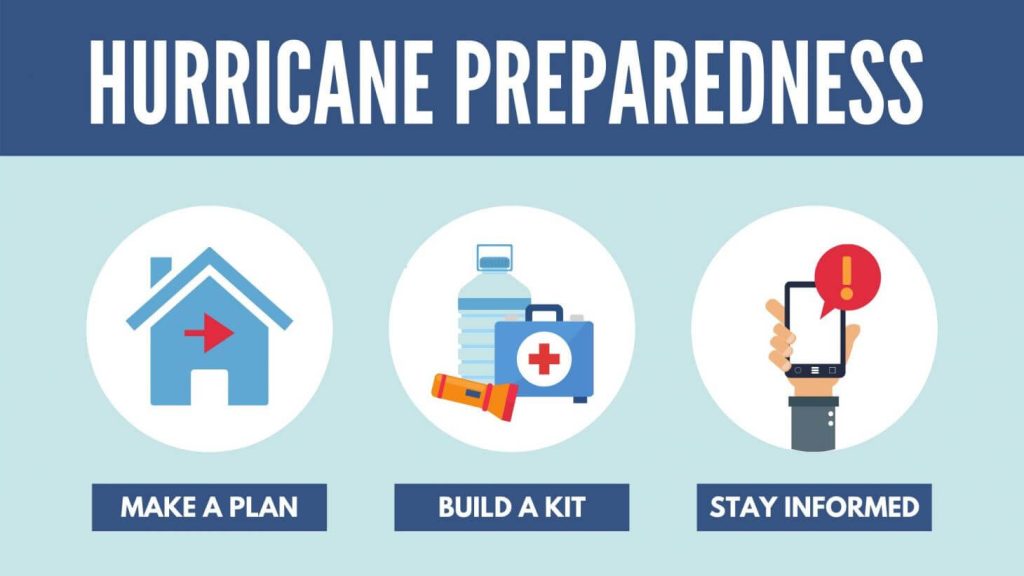Hurricanes are among the most powerful and destructive natural disasters, capable of causing widespread damage to communities, infrastructure, and lives. Preparation is key to minimizing the impact of these storms and ensuring the safety of yourself and your loved ones.
In this comprehensive guide, we will walk you through essential steps to take before, during, and after a hurricane to protect your home, your family, and your property.
From creating an emergency plan to understanding evacuation procedures and securing your home, we’ve compiled expert advice to help you navigate the complexities of hurricane preparedness. By taking proactive measures and staying informed, you can face these extreme weather events with confidence and resilience.
Read More: Your Ultimate Guide to Hurricane Preparedness
Understanding Hurricane Terminology
To effectively prepare for a hurricane, it is crucial to understand the terminology used in forecasts and warnings. Storm conditions can vary in terms of intensity, size, and even the direction in which a tropical cyclone approaches your area.
Therefore, grasping what forecasters and news reporters are communicating is vital for your safety.Hurricanes are classified based on wind speed. A Tropical Depression has winds of up to 38 mph, while a Tropical Storm has winds ranging from 39 to 73 mph. A Hurricane begins at 74 mph.
The upper right quadrant of a storm, particularly near the eye, is typically the most intense, posing significant threats like damaging winds, storm surge, and flooding. For example, Hurricane Katrina brought devastating 28-foot storm surges to the Louisiana and Mississippi coastlines.
Here are key terms to know:
Tropical Storm Watch:
Tropical storm conditions are possible in the area.
Hurricane Watch:
Hurricane conditions are possible in the area. Watches are issued 48 hours in advance of anticipated tropical storm force winds.
Tropical Storm Warning:
Tropical storm conditions are expected in the area.
Hurricane Warning:
Hurricane conditions are expected in the area. Warnings are issued 36 hours before tropical storm force winds are expected.
Additional terms:
Eye:
The calm center of the storm.
Eye Wall:
The most severe part of the storm, surrounding the eye, with the highest wind speeds and precipitation.
Rain Bands:
Bands extending from the cyclone, often bringing heavy rain, winds, and tornadoes.
Storm Surge:
A dangerous rise in ocean water, causing rapid flooding along the coast and sometimes further inland.
Interpreting Hurricane Forecasts
Forecasting the path and behavior of a tropical cyclone is a complex process influenced by a range of global and regional factors. A storm’s size and trajectory are key elements that interact with surrounding wind patterns—either steering the system, accelerating its development, or limiting its growth.
Because of this dynamic interplay, predicting a storm’s path with precision can be difficult.Meteorologists rely on sophisticated computer models that analyze massive amounts of atmospheric and oceanic data.
These models help forecast a storm’s movement, typically offering fairly accurate predictions within a 2–3 day window. You may hear terms like computer models or spaghetti models, which refer to various simulation outputs used to project possible storm tracks.
The forecast track—often displayed as a cone of uncertainty—is based on a consensus of these models. For the most reliable and timely updates on tropical cyclone activity, storm forecasts, and expert analysis, the National Hurricane Center (NHC) serves as the authoritative source.
They provide regular advisories, discussions, and alerts that are critical for public safety and preparedness.
How Hurricanes Are Named
Hurricane names are selected from pre-determined lists that are rotated and reused every six years. These names are assigned randomly from lists developed by the World Meteorological Organization to ensure clarity and effective communication during storm tracking and public advisories.
However, if a hurricane is exceptionally destructive or deadly such as Katrina, Charley, or Irene—its name is permanently retired. This practice helps avoid confusion and maintains sensitivity when referencing past catastrophic events. Retired names are replaced with new ones to maintain the integrity of future naming lists.
Assembling a Hurricane Emergency Kit
Preparing a well-stocked hurricane emergency kit is essential for both evacuation and sheltering in place. In the event of a storm, disruptions to power, water, and communication systems are likely, and having immediate access to necessary supplies can significantly reduce stress and ensure your safety.
One of the most common issues during hurricane warnings is mass panic buying, leading to empty store shelves and unnecessary chaos. By assembling your kit in advance, you avoid last-minute scrambles and ensure you’re fully prepared.
Your emergency kit should be packed in a portable, easy-to-carry bag or container in case you need to evacuate quickly.
| Item | Purpose/Details |
|---|---|
| Non-perishable food | Minimum 3-day supply to sustain nourishment during outages |
| Water | At least 1 gallon per person per day for 3 days |
| First-aid kit | Include bandages, antiseptics, and essential prescription medications |
| Personal hygiene and sanitation products | Maintain cleanliness and prevent illness |
| Flashlights with spare batteries | Provide light during power outages |
| Battery-powered or hand-crank radio | Stay informed with weather alerts and emergency broadcasts |
| Waterproof container for documents and cash | Protect critical papers (ID, insurance, bank info) and emergency funds |
| Manual can opener | Access canned goods without power |
| Matches or a lighter | Useful for lighting candles or starting a fire if necessary |
| Entertainment items | Books, magazines, cards, or games to pass time |
| Special needs items | Baby formula, diapers, pet food, or medications for specific needs |
| Cooler and ice packs | Store perishable food or medication temporarily |
| Evacuation and communication plan | Ensure all family members know the plan and meet-up points if separated |
Planning ahead with these essentials ensures you’re ready to respond confidently and calmly when a hurricane approaches.
Securing Your Home Against Hurricanes
Protecting your home from the impact of hurricanes is crucial for minimizing damage caused by high winds, storm surge, and flooding.
Begin by safeguarding all windows using hurricane shutters or securely fitted plywood; while window tape may reduce shattered glass from scattering, it will not stop the window from breaking.
Strengthen your home’s structure by installing roof straps or clips that anchor the roof to the frame, increasing resistance to powerful winds.Landscaping also plays a role in storm safety—trim trees and shrubs to reduce debris and ensure rain gutters are clear to facilitate proper drainage.
Reinforce garage doors, as they are particularly vulnerable to wind pressure. Bring indoors any unsecured outdoor items such as patio furniture, trash bins, or lawn decorations to prevent them from becoming airborne hazards.
Finally, if winds intensify, stay away from windows and doors, and secure interior doors to reduce pressure and improve safety within your home.
Power Outages: Staying Safe and Prepared
Power outages are a common consequence of hurricanes, and preparing for them is just as important as your broader storm readiness efforts. Start by filling your gas tank well in advance of an approaching storm—waiting too long often means long lines or empty pumps as demand surges.
It’s also wise to keep extra cash on hand, as ATMs and card payment systems may be unavailable if power is down. Charge your cell phone ahead of time and conserve battery life once the electricity goes out, using your device only for essential communication.
One of the most uncomfortable effects of losing power is the loss of air conditioning. To keep your home as cool as possible, cover windows from the inside to block sunlight and retain cooler air.
Use battery-operated or backup fans only when you’re in the room, as they create a wind-chill effect but do not actually lower room temperature—and may even contribute to heat buildup if left running continuously.
In preparation for water interruptions, fill bathtubs and large containers with water for non-drinking purposes such as washing and flushing. Adjust your refrigerator to its coldest setting and freeze items you can afford to, such as bottled water or perishable foods, to help preserve them during an outage.
Keep a cooler stocked with ice packs ready to store essential items after four hours without power. Be sure to follow official food safety guidance to determine when to discard refrigerated goods to avoid illness.Finally, keep in mind the full hurricane timeline—Approach, Arrival, and Aftermath.
Each phase demands preparation, awareness, and action. Listen to official instructions, secure your property or find shelter when needed, and take every measure to remain safe once the storm has passed.
Preparedness can significantly reduce the disruption and danger that power outages bring during a hurricane.
Frequently Asked Questions (FAQ)
When is hurricane season?
Hurricane season in the Atlantic typically runs from June 1 to November 30, with the peak occurring between August and October. It’s crucial to remain vigilant throughout this period.
What is the difference between a hurricane watch and a hurricane warning?
A hurricane watch means hurricane conditions are possible within the area—typically issued 48 hours in advance. A hurricane warning means hurricane conditions are expected, usually issued 36 hours before the anticipated onset of tropical-storm-force winds.
How strong does wind have to be for a storm to be classified as a hurricane?
A storm becomes a hurricane when sustained winds reach 74 mph or more. It may be classified into five categories based on wind speed, with Category 5 being the most intense.
What should I include in my hurricane emergency kit?
Your kit should include non-perishable food, water (three-day supply), first-aid essentials, flashlights, a battery-powered radio, medications, cash, important documents, and any special needs items such as pet or baby supplies.
Can I stay home during a hurricane?
That depends on the storm’s severity and your location. If you live in a mandatory evacuation zone, you should evacuate immediately when directed. If not, ensure your home is secure and adequately stocked to safely shelter in place.
What’s the safest part of the house during a hurricane?
Stay in a small, windowless interior room or hallway on the lowest level of your home. Avoid rooms with glass windows or skylights.
Conclusion
Hurricanes are among nature’s most powerful and unpredictable forces, capable of causing widespread devastation in a matter of hours. But with the right knowledge, preparation, and timely action, you can significantly reduce your risk and ensure the safety of yourself and your loved ones. From understanding forecasts and securing your home to assembling a well-stocked emergency kit and planning for power outages, each step you take today can make a critical difference tomorrow.

